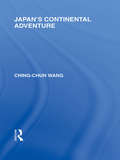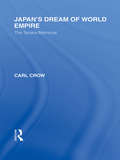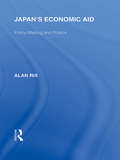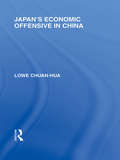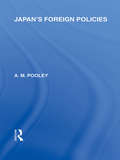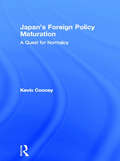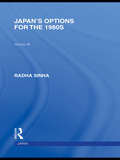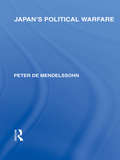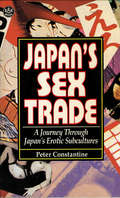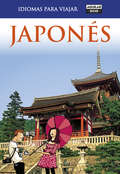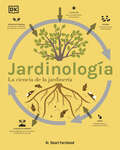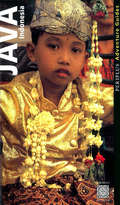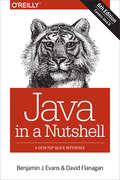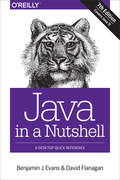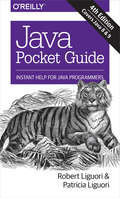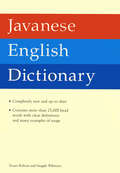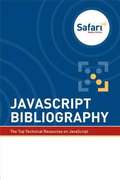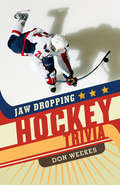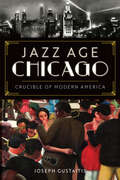- Table View
- List View
Japan's Continental Adventure (Routledge Library Editions: Japan)
by Ching-Chun WangThis book contains eighteen studies on various important phases of Japan’s invasion of China. The appendix contains the historical declaration by Chiang-Kai-shek setting forth clearly the reasons why China took up arms against Japanese aggression, and a lucid chapter by the veteran sinologist Owen Lattimore on what Korea pays for Japan’s rule. Ever since the invasion of Manchuria by Japan in September 1931 the writer called attention to the fact that, in view of the League commitments, aggression in the East, if not properly stopped according to the League Covenant, would encourage aggression to spread beyond the limits of Asia.
Japan's Dream of World Empire: The Tanaka Memorial (Routledge Library Editions: Japan)
by Carl CrowDescribed as the Japanese Mein Kampf, this small pamphlet outlines the history of Japan which by the late 1920s was, according to the author, becoming a dream for world domination. Although this did not come to fruition, the book nonetheless represents a fascinating insight into the national psyche and political and military planning of the Japanese in the first half of the twentieth century. It focuses particularly on the Japanese policy in Manchuria and Mongolia.
Japan's Economic Aid: Policy Making and Politics (Routledge Library Editions: Japan)
by Alan RixJapan’s arrival since World War Two as a major industrial nation has meant that she has had to bear a greater share of the developed world’s contribution to the developing nations and foreign aid has become an integral part of foreign policy. This book describes the roots of Japan’s aid policy and shows that this side of her international economic policy is based largely on domestic conditions, structures and forces. To understand the pattern of Japanese aid as it stands today, it is important to appreciate the complexities of the Japanese decision-making process. This book clearly explains the patterns of Japanese aid policy-making.
Japan's Economic Offensive in China (Routledge Library Editions: Japan)
by Lowe Chuan HuaThis volume exposes Japan’s motives and designs on the economic front, pointing out the dangers of her policy of ousting Western interests and influence from East Asia during the conflict with China in Manchuria. The author urges the American and British governments to reconsider their position and strategy towards Japan. This book represents a fascinating insight into the power struggle between Japan & China in the early twentieth century.
Japan's Foreign Aid Challenge (Routledge Library Editions: Japan)
by Alan RixWhen this volume was published in 1993 it was the first comprehensive analysis of the major policy issues confronting Japan’s massive foreign aid programme. It deals with the philosophy behind Japan’s aid, Japanese reactions to the severe criticisms of its programmes and the beginnings of meaningful administrative reform of the complex aid system. Alan Rix goes on to examine the widespread innovation in programmes and policies to make Japan’s aid more responsive and the impact of the Asian bias in Japan’s aid.
Japan's Foreign Policies (Routledge Library Editions: Japan)
by A M PooleyThis volume draws together material from The Japan Chronicle, The Japan Gazette and the China Treaty Port foreign papers, all of which are of great historical value. The Japan and China Treaty Port foreign papers frequently contain important articles translated from the vernacular press. These original articles were often written by leading politicians and statesmen – Count Mutsu, Count Hayashi, Tang-shao-Yi, Wu-ting-Fang and Liang-chi-Chao were all prolific contributors. Written with the prospect of World War II looming, the rapid changes in the Far East happened almost without the West realising. This volume makes available key documents and analyses Japanese foreign policy with a view to directing UK handling of a delicate diplomatic situation in the Far East.
Japan's Foreign Policy Maturation: A Quest for Normalcy (East Asia: History, Politics, Sociology and Culture)
by Kevin CooneyThe sudden end of the Cold War took the Japanese foreign policy community by surprise. The Yoshida Doctrine which served Japanese foreign policy so well during the Cold War is no longer a viable foreign policy option. This dissertation examines the restructuring of Japanese foreign policy since the end of the Cold War. Through a series of 56 interviews with Japanese foregin policy elites, the changes in Japanese foreign policy are put into the context of the foreign policy literature.
Japan's Options for the 1980s (Routledge Library Editions: Japan)
by Radha SinhaJapan’s economic success since the 1950s created a range of serious domestic and international problems which threaten the stability of the country. Within Japan at the start of the 1980s there was a strong mood on the right for remilitarization to give the nation the super-power status her economic performance justified. Outside Japan, there was increasing pressure from the West to make her conform to Western strategic interests. Against the background of these crucial issues the book analyzes the economic, political and military options open to Japan. Focussing on the interconnecting themes of foreign harassment and domestic economic disorder, the author points out many areas of similarity between Japan of the 1930s and Japan of the 1980s.
Japan's Political Warfare (Routledge Library Editions: Japan)
by Peter de MendelssohnAfter more than six years of active fighting in the Far East and over two years of open war between Japan and the Anglo-Saxon powers, Japanese political warfare was still a factor largely unknown in the Western world. Overshadowed by the much nearer and more closely felt exertions of the Nazi propaganda machine, it came to be regarded as too remote to have any noticeable bearing on the general course of the war. In the months leading up to Pearl Harbour, Tokyo Radio, the official Domei News Agency and the Japanese press jointly conducted an efficient war of nerves which, for all its alleged clumsiness effectively deceived many in Britain and the USA. The attack on Pearl Harbour showed how Tokyo’s political warfare achieved its object: the creation of a political smoke-screen. During the period of Japan’s conquests in 1942 following Pearl Harbour, and before that in China, Japan’s political warfare showed itself quite capable of producing useful results.The volume is divided into two parts: the first deals with machinery and methods and gives as full and detailed a survey of the various government organs directing and controlling political warfare, the structure of the Japanese press, the organisation of Japanese broadcasting, the functioning of censorship and the extent to which education, science, literature, the arts and the cinema are being employed for purposes of propaganda, both in the Japanese homeland and in the wider area of the conquered empire. The second part deals with the aims and policies of Japanese propaganda, and attempts to give an outline of the way in which the machinery is being operated. It includes an analysis of the main groups of standard slogans and catchphrases which recur everywhere in Japanese propaganda and a special chapter is devoted to the use made of religion for purposes of political warfare.
Japan's Sex Trade
by Peter ConstantineJapan's Sex Trade offers a probing, step by step tour of the country's astonishing professional sex scene: salacious soaplands, hedonistic health clubs, and startling S&M snackbars, as well as the colorful characters who populate them and the off-color language they use. Highlighted are menus of the sexual services offered in each particular area of the red-light"floating worlds" with all specialties unblushingly detailed.As the reader journeys from act to act and location to location, a panorama of the amazing eccentricity of the Japanese sex business emerges. Scandalous and controversial, this picture will fascinate the reader
Japonés (Idiomas para viajar #Volumen)
by El País-AguilarIdiomas para viajar ofrece ahora unos contenidos mucho más amplios y completos. Cada guía recoge todo lo que se necesita para desenvolverse durante el viaje: una guía de pronunciación, un resumen gramatical y un manual básico del idioma como introducción a todos los bloques temáticos pensados para resolver situaciones según avanza el viaje (llegada, desplazamientos, alojamiento, restaurantes, ocio, compras, salud, emergencias#). Un código de colores distingue los diferentes bloques temáticos para facilitar la consulta. Todos los capítulos tienen, además de introducciones prácticas del país, un vocabulario imprescindible y expresiones habituales, con sus correspondientes transcripciones. La guía concluye con un nuevo diccionario bilingüe, que contiene todas las palabras de uso habitual en la comunicación diaria.
Jardinología (The Science of Gardening): La ciencia de la jardinería
by Dr. Stuart FarrimondUn libro de jardinería diferente que explica la ciencia detrás de la jardinería de forma visual y clara.¿El mundo de la botánica y la jardinería te parecen un misterio? Las guías de jardinería al uso tienden a dar gran cantidad de instrucciones y consejos, pero rara vez aportan explicaciones sobre el por qué. ¡No te preocupes! El Dr. Stuart Farromond arroja luz sobre todas esas preguntas que siempre te has hecho y te explica lo que sucede en tu jardín desde un enfoque científico.La guía botánica definitiva para entender los secretos de la horticultura y la floricultura como un profesional:Escrita con un lenguaje accesible y libre de tecnicismos en formato pregunta y respuesta. Con explicaciones claras, apoyadas por gráficos y esquemas para ilustrar los conceptos de forma visual.Estructurado en torno al ciclo de vida de un jardín, desde los primeros brotes hasta el momento de la poda.Explica los beneficios de la jardinería para la salud mental y el medio ambiente.Un práctico manual de jardinería con explicaciones y consejos avalados por la ciencia, que te ayudará a comprender mejor cómo se comportan las plantas, desmitificar creencias y descubrir las bases y avances de la horticultura moderna. ------------------------The only book to explain the science behind gardening practice in a simple and visually accessible way.The world of gardening can be a mystifying place, with so many instructions to follow and often little explanation as to why. Dr. Stuart Farromond casts his scientific eye over a typical year in the garden to answer all the horticultural questions you&’ve ever wanted the answer to. This great gardening book provides a shortcut to decades of gardening experience by explaining the science behind how a garden grows, featuring: An accessible guide structured around the life cycle of the garden, taking you from first shoots to pruning for renewal. An accessible Q &A format, with stats and infographics to bring the story to life, as well as long-held gardening myths are exploded by new science. Every way to greener fingers has an action point so that you can understand the science, apply your gardening practice, and enjoy a flourishing garden.From hands-on, practical advice, to an exploration of the mental health benefits of gardening, while also covering topics such as the positive impact gardening can have on the earth during a time of climate crisis in between, The Science of Gardening debunks myths and reveals the latest science only taught at horticultural college. As a passionate newcomer to gardening, daunted by the mountain of often conflicting advice in gardening manuals, Dr. Stu has set about testing the scientific basis of so much conventional wisdom and practice so you too can garden like a pro.
Java: An Eventful Approach
by Kim B. Bruce Andrea Pohoreckyj Danyluk Thomas P. MurtaghJava, an object-oriented language with many standard libraries, offers both complexities and opportunities. This introductory book makes use of a new approach to understanding programming in Java. Provides an objects-first approach to programming. Introduces object-oriented graphics and writing methods early in the book. Motivates readers to use event-driven programming. Reinforces the importance of understanding several threads. For anyone interested in the programming language of Java.
Java Adventure Guide
by Periplus EditorsThe ultimate adventure guideThis is the most comprehensive guide to Java ever produced. Hundreds of pages of travel tips and dozens of lively articles on history, nature, and the arts, take you right under the surface of Javanese life, with visits to lots of unique places.Under the volcanoJava's 121 active volcanoes rumble and roar above one of the world's most dramatic tropical landscapes. Whether you come here to trek the volcanoes or to visit the island's impressive ancient monuments, Java provides the adventure of a lifetime.The nitty gritty, from A to ZDetailed maps of all areas of interest are included along with personal recommendations from our expert authors on how to get around, where to stay and eat, and how to get the best value for your money.
Java Adventure Guide
by Periplus EditorsThis is the most comprehensive guide to Java ever produced. Hundreds of pages of travel tips and dozens of lively articles on history, nature and the arts, take you right under the surface of Javanese life, with visits to lots of unique places. Detailed maps of all areas of interest are included along with personal recommendations from our expert authors on how to get around, where to stay and eat, and how to get the best value for your money.
Java in a Nutshell
by Benjamin J Evans David FlanaganThe latest edition of Java in a Nutshell is designed to help experienced Java programmers get the most out of Java 7 and 8, but it's also a learning path for new developers. Chock full of examples that demonstrate how to take complete advantage of modern Java APIs and development best practices, the first section of this thoroughly updated book provides a fast-paced, no-fluff introduction to the Java programming language and the core runtime aspects of the Java platform.The second section is a reference to core concepts and APIs that shows you how to perform real programming work in the Java environment.Get up to speed on language details, including Java 8 changesLearn object-oriented programming, using basic Java syntaxExplore generics, enumerations, annotations, and lambda expressionsUnderstand basic techniques used in object-oriented designExamine concurrency and memory, and how they're intertwinedWork with Java collections and handle common data formatsDelve into Java's latest I/O APIs, including asynchronous channelsUse Nashorn to execute JavaScript on the Java Virtual MachineBecome familiar with development tools in OpenJDK
Java in a Nutshell: A Desktop Quick Reference (Seventh Edition) (In a Nutshell)
by David Flanagan Ben Evans<p>This updated edition of Java in a Nutshell not only helps experienced Java programmers get the most out of Java versions 9 through 11, it’s also a learning path for new developers. Chock full of examples that demonstrate how to take complete advantage of modern Java APIs and development best practices, this thoroughly revised book includes new material on Java Concurrency Utilities. <p>The book’s first section provides a fast-paced, no-fluff introduction to the Java programming language and the core runtime aspects of the Java platform. The second section is a reference to core concepts and APIs that explains how to perform real programming work in the Java environment. <p>Get up to speed on language details, including Java 9-11 changes; Learn object-oriented programming, using basic Java syntax; Explore generics, enumerations, annotations, and lambda expressions; Understand basic techniques used in object-oriented design; Examine concurrency and memory, and how they’re intertwined; Work with Java collections and handle common data formats; Delve into Java’s latest I/O APIs, including asynchronous channels; Use Nashorn to execute JavaScript on the Java Virtual Machine; Become familiar with development tools in OpenJDK.</p>
Java Pocket Guide: Instant Help for Java Programmers
by Robert Liguori Patricia LiguoriAny time you need quick answers for developing or debugging Java programs, this pocket guide is the ideal reference to standard features of the Java programming language and its platform. Youâ??ll find helpful programming examples, tables, figures, and lists fastâ??including Java 9 features such as modular source code and the new JShell interactive command-line REPL. Itâ??s a handy companion, whether youâ??re in the office, in the lab, or on the road.This book also provides material to help you prepare for the Oracle Certified Associate Java Programmer exam.Quickly find Java language details, such as naming conventions, types, statements and blocks, and object-oriented programmingGet details on the Java SE platform, including development basics, memory management, concurrency, and genericsUse new features in Java 9, including modular source code and JShellBrowse through information on basic input/output, NIO 2.0, the Java collections framework, and the Java Scripting APIGet supplemental references to fluent APIs, third-party tools, and basics of the Unified Modeling Language (UML)
Javanese English Dictionary
by Stuart Robson Singgih WibisonoThis is the most complete and and up-to-date Javanese dictionary available.The Javanese-English Dictionary is the only reference source to provide a complete listing, with clear English translations and explanations, of all current terms used in modern Javanese. It covers the whole vocabulary needed both for everyday communication and in order to read published materials, and is a resource long needed by language scholars, students of Javanese history and society and visitors with an interest in the traditional culture of Java. With more than 25,000 headwords, it also includes local forms likely to be encountered in travel, specialist terms associated with the traditional arts of the area and obsolete words still to be found in literature.The dictionary also contains clear explanations of Javanese culture, folklore and religious practices. Users will gain an insight into traditional Javanese cuisine, costume, crafts and the performing arts, and will be able to identify local flora and fauna.Javanese-English Dictionary includes:Completely new and up-to dateContains more than 25,000 heard words with clear definitionsExtensive examples of usage.Information on Javanese culture and historyUnique Javanese idioms and expressionsSpecial treatment of the unique elements Javanese grammar and syntax
Javanese English Dictionary
by Singgih Wibisono Stuart RobsonThis is the most complete and and up-to-date Javanese dictionary available.The Javanese-English Dictionary is the only reference source to provide a complete listing, with clear English translations and explanations, of all current terms used in modern Javanese. It covers the whole vocabulary needed both for everyday communication and in order to read published materials, and is a resource long needed by language scholars, students of Javanese history and society and visitors with an interest in the traditional culture of Java. With more than 25,000 headwords, it also includes local forms likely to be encountered in travel, specialist terms associated with the traditional arts of the area and obsolete words still to be found in literature.The dictionary also contains clear explanations of Javanese culture, folklore and religious practices. Users will gain an insight into traditional Javanese cuisine, costume, crafts and the performing arts, and will be able to identify local flora and fauna.Javanese-English Dictionary includes:Completely new and up-to dateContains more than 25,000 heard words with clear definitionsExtensive examples of usage.Information on Javanese culture and historyUnique Javanese idioms and expressionsSpecial treatment of the unique elements Javanese grammar and syntax
Javanese English Dictionary
by Singgih Wibisono Stuart RobsonThis is the most complete and and up-to-date Javanese dictionary available.The Javanese-English Dictionary is the only reference source to provide a complete listing, with clear English translations and explanations, of all current terms used in modern Javanese. It covers the whole vocabulary needed both for everyday communication and in order to read published materials, and is a resource long needed by language scholars, students of Javanese history and society and visitors with an interest in the traditional culture of Java. With more than 25,000 headwords, it also includes local forms likely to be encountered in travel, specialist terms associated with the traditional arts of the area and obsolete words still to be found in literature.The dictionary also contains clear explanations of Javanese culture, folklore and religious practices. Users will gain an insight into traditional Javanese cuisine, costume, crafts and the performing arts, and will be able to identify local flora and fauna.Javanese-English Dictionary includes:Completely new and up-to dateContains more than 25,000 heard words with clear definitionsExtensive examples of usage.Information on Javanese culture and historyUnique Javanese idioms and expressionsSpecial treatment of the unique elements Javanese grammar and syntax
JavaScript Bibliography
by Safari Books Online Content TeamJavaScript used to be notoriously difficult to work with. Everything had to be written from scratch, every browser worked differently, and common development niceties like debuggers didn’t exist. Now JavaScript has all of the tools that developers need. Libraries like jQuery, AngularJS, Backbone.js and Ember.js make it easier to support a wide variety of browsers. Unit testers like Yui Test and QUnit make it possible to write rock solid, tested code. And all modern browsers included a suite of developer tools to ease the pains of building web apps. We have chosen in this bibliography a selection of JavaScript books that can take you from newbie all the way to ninja. Begin by learning the basics and best practices. Once you are comfortable, move onto more advanced topics like unit testing, performance enhancements, and design patterns. Learn how libraries like AngularJS, Backbone.js, Ember.js and jQuery can increase your productivity. Step into the fast growing world of mobile development with web frameworks like jQuery Mobile and cross-platform frameworks like PhoneGap. And finally, go full circle with JavaScript on the server with Node.js. With JavaScript you can create dynamic websites for desktop and mobile browsers, create fast and efficient servers, and build apps to sell for nearly every smartphone market place. JavaScript’s popularity is poised for continued growth and this bibliography can help you to grow your JavaScript skills.
Jaw Dropping Hockey Trivia
by Don WeekesFrom the scoring exploits of historic greats like Gordie Howe, Dit Clapper and Joe Malone to hockey heroics ripped from yesterday's headlines--including the wild 2011 Cup final between the Boston Bruins and the Vancouver Canucks--these quizzes and games will test the knowledge and stoke the passions of hockey fans everywhere.In eight cleverly constructed theme chapters, among them a chapter on swashbuckling Stanley Cup clashes and another on the on-ice drama at the Vancouver 2010 Olympics, renowned hockey trivia master Don Weekes takes the reader on a colourful journey through hockey lore. From glorious victories to hilarious interview quotes, the greatest sport on ice is crammed, in all its zany glory, into this terrific trivia collection.
The Jaws Log: 30th Anniversary Edition (Shooting Script Ser.)
by Carl GottliebWinner of three Oscars and the highest-grossing film of its time, Jaws was a phenomenon, and this is the only book on how twenty-six-year-old Steven Spielberg transformed Peter Benchley's number-one bestselling novel into the classic film it became.Hired by Spielberg as a screenwriter to work with him on the set while the movie was being made, Carl Gottlieb, an actor and writer, was there throughout the production that starred Roy Scheider, Robert Shaw, and Richard Dreyfuss. After filming was over, with Spielberg's cooperation, Gottlieb chronicled the extraordinary yearlong adventure in The Jaws Log, which was first published in 1975 and has sold more than two million copies. This expanded edition includes a photo section, an introduction by Benchley, and an afterword by Gottlieb that gives updates about the people and events involved in the film, ultimately providing a singular portrait of a famous movie and inspired moviemaking.
Jazz Age Chicago: Crucible of Modern America
by Joseph GustaitisWhen people imagine 1920s Chicago, they usually (and justifiably) think of Al Capone, speakeasies, gang wars, flappers and flivvers. Yet this narrative overlooks the crucial role the Windy City played in the modernization of America. The city's incredible ethnic variety and massive building boom gave it unparalleled creative space, as design trends from Art Deco skyscrapers to streamlined household appliances reflected Chicago's unmistakable style. The emergence of mass media in the 1920s helped make professional sports a national obsession, even as Chicago radio stations were inventing the sitcom and the soap opera. Join Joseph Gustaitis as he chases the beat of America's Jazz Age back to its jazz capital.
